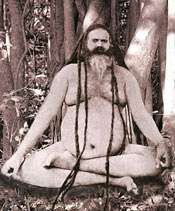Totapuri
| Ishwar Totapuri | |
|---|---|
 | |
| Born |
1761 Punjab, India |
| Nationality | Indian |
| Denomination | Dashanami Sampradaya |
| Philosophy | Advaita Vedanta |
| Notable disciple(s) |
Ramakrishna Anandpuri |
Ishwar Totapuri, not to be confused with Totapuri Maharaj, was most likely born in the Punjabi Suba of Mughal, India some time in the mid-17th century (most likely in 1630CE). Ishwar Totapuri may be a disciple of Totapuri Maharaj, who has probably assumed and added Totapuri to his name as reverence to his Gurudev (Totapuri Maharaj).
Totapuri Maharaj was a naked Naga Sidha Guru belonging to Satnami Puri Sampradaya of Adi Sankar (or Acharya Sankar or Sri Sankar Bhagavadpad). He was that an Indian saint, also known as Brahmavid Baristh Digambar Paramhans, who was a parivrajaka (wandering monk) who followed the path of the Monism Advaita Vedanta in its truest form. He was a Advaiteen. However, towards the last part of his Parivrajak Sanyas life, he settled, establishing his Ashram (Advait Brahma Ashram) on a sand dune named GIRNARBANT in Srikhetra PURI in Odisha until his last teaching and professing Advaitvad.
He is said to have taught many prominent saints, including Sri Ramakrishna Paramahansa. There is very few writing available about him, as he discoured his followers from writing about him. There are a few books written in Bengali/Hindi and Odia literature depicting some pages on his life and philosophy available in Advait Brahma Ashram Girnarbanta Lokanath Road PURI in Odisha.[1]
By the time he arrived at Dakshineswar Temple in 1862–63, he was a wandering monk of the Dasnami order of Adi Shankara and head of a monastery in the Punjab, claiming leadership of seven hundred sannyasins. He initiated Ramakrishna into Advaita Vedanta,[2] as well as Anandpuri Ji from the Advait Mat tradition.[3]
Totapuri taught Ramakrishna that the sole reality of the impersonal absolute could only be realized in a state of consciousness devoid of all conceptual forms.[4] Ramakrishna described Totapuri as "a teacher of masculine strength, a sterner mien, a gnarled physique, and a virile voice" and addressed him affectionately as Nangta, the "Naked One", because as a renunciate he did not wear any clothing.[2]
References
- ↑ Comans, Michael (1993). "The Question of the Importance of Samadhi in Modern and Classical Advaita Vedanta". Philosophy East & West. 43 (1): 33.
The time [Ramakrishna] spent under the direction of Totapuri, who was said to be an Advaitin, was much shorter than the time spent studying Tantra, and the information available on Totapuri is very meager.
- 1 2 Swami Nikhilananda, The Gospel of Sri Ramakrishna (1972), Ramakrishna-Vivekananda Center, New York
- ↑ Geaves, R. R., From Totapuri to Maharaji: Reflections on a Lineage (Parampara) (2007), in Indian Religions: Renaissance and Revival, ed. Anna King. London: Equinox, 2007
- ↑ Von Dehsen, Christian D. (Ed.) WritersPhilosophers and Religious Leaders p.159, Oryx Press, 1999